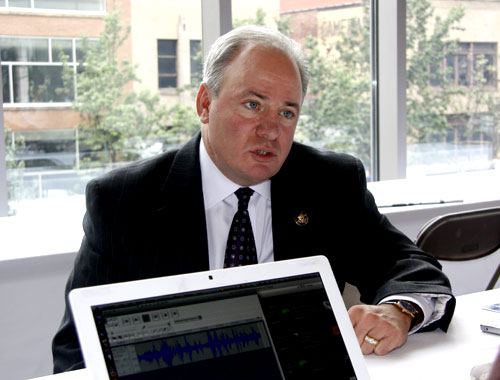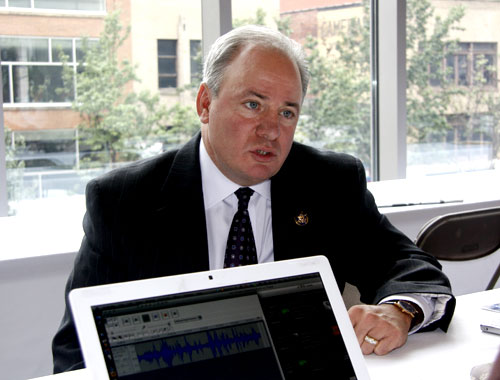 Rep. Mike Doyle chats with Grist.Photo: G20VoiceDuring last week’s G20 Summit in Pittsburgh, Rep. Mike Doyle (D-Penn.) was out and about networking with climate-action advocates and talking up the city’s green cred. A southwestern Pennsylvania native, Doyle comes from a steelworking family and has been a friend to the industry during his nine years in Congress. But he’s also an outspoken proponent of the greening of Pittsburgh, where environmental cleanup, green jobs growth, energy-efficient building, and cleantech R&D have transformed a dying steel town into a lively pioneer of 21st century urban revitalization.
Rep. Mike Doyle chats with Grist.Photo: G20VoiceDuring last week’s G20 Summit in Pittsburgh, Rep. Mike Doyle (D-Penn.) was out and about networking with climate-action advocates and talking up the city’s green cred. A southwestern Pennsylvania native, Doyle comes from a steelworking family and has been a friend to the industry during his nine years in Congress. But he’s also an outspoken proponent of the greening of Pittsburgh, where environmental cleanup, green jobs growth, energy-efficient building, and cleantech R&D have transformed a dying steel town into a lively pioneer of 21st century urban revitalization.
Doyle, a senior member of the House Energy and Commerce Committee, was an early critic of the Waxman-Markey climate and clean energy bill. But he eventually emerged as a major supporter of the legislation, brokering components that would benefit the industrial and manufacturing sectors and whipping up votes that helped the bill squeak to passage in June. With Rep. Jay Inslee (D-Wash.), Doyle crafted a compromise measure that in the bill’s first 10 to 15 years would give away a mass of greenhouse-gas pollution credits to heavy industries facing intense overseas competition (such as steel, natch), as well as to power distribution companies serving local electric utilities.
While Doyle’s amendment angered some climate advocates, others feel he played a critical role in swaying enough of his fellow “Brown Dog Democrats” to pass the bill.
During the G20 last week, Doyle sat down for a quick chat with Grist about congressional climate politics, clean energy jobs, and the greening of Pittsburgh.
—–
Q. Let’s jump right in: From your perspective, what’s it going to take to get a carbon cap-and-trade measure through the Senate?
A. Hopefully the House bill hasn’t set the ceiling, and the Senate bill is going to set the floor.
It remains to be seen. The ultimate work is going to get done in the conference, as we put the House and the Senate bills together. I think the message we’re trying to convey to the Senate, and to others who were initially skeptical about whether this could be done in a way that didn’t devastate the economy, is that this can be a win-win situation.
Q. By win-win, you mean climate and economy, right? Your district is rich in coal and steel, and yet you brought many important constituents around to supporting the House climate and energy bill.
A. When this bill was first introduced in the House, I heard from the industries, and they were panicked that this was going to devastate the steel industry [and] jobs in western Pennsylvania.
I remember telling John Surma, the CEO of U.S. Steel, that he could either be at the table or on the menu. We were moving forward, and I wanted him to come to Washington, D.C., sit down with Ed Markey [D-Mass.] and Henry Waxman [D-Calif.] and those of us on the [Energy and Commerce] Committee, and talk about how reducing carbon emissions impacts his industry [in relation to] other countries that don’t have [climate] regimes yet and are his competitors, and how we could fashion legislation in such a way that we could have a win-win situation.
It was really out of those discussions that the Doyle-Inslee amendment [PDF] was born in the House, which basically says to our industries that if they become more efficient and lower their carbon footprints and do that better than the sector average, we would reward that, and we’d do it in a way that was WTO [World Trade Organization] compliant. We’re saying to steel, “We’ll give you the level playing field you need until such time that we get agreements with other countries that you’re competing with.”
Q. Being a hometown boy must have helped.
A. I get a certain amount of street cred, just ’cause I grew up here, and my dad and my grandpap — we’re a steel family. So it’s sort of like, “He wouldn’t screw us. He’s one of our guys.”
Q. The major competitor is China, which, as a developing nation, is not required to take on binding emission-reduction targets under the Kyoto climate treaty.
A. We’ve always had this debate in the Congress: “We don’t want to do anything ’til the Chinese do something.” For eight years, we had a president who said, “We’re not doing anything until the rest of the world does something.” And we did nothing.
Well, we all understand that America’s going to have to lead this; that when we lead, then it gives President Obama and future administrations the leverage they need to say to developing countries, “Join us.”
Q. I think it was surprising to many people beyond the Beltway that there was so much Democratic resistance to the Waxman-Markey bill.
A. It’s almost regional. [In] states like Pennsylvania and Ohio and West Virginia, where coal is king and supplies our electricity, we had to say, “How do we approach these early targets?” Our target is 80 percent reductions by the year 2050, but the toughest part is getting started.
Part of the strategy in the House bill was to mitigate some of these impacts early on, in areas that were coal-intensive, until we can get technologies on board to help them reduce emissions. Because under the early scheme, they’re not going to meet the caps, because there’s no carbon-capture-and-sequestration technology deployable as we speak today. So they’re going to have to buy credits. The theory [being promoted by opponents] is that they’re going to buy these credits and pass them right through to the ratepayers, and everybody’s going to pay more. We solved that problem in the bill.
Q. But there’s still a massive amount of misinformation going out to the American public about all of those measures.
A. No question. Last week, one of [Pittsburgh’s] two major papers did two editorials, one calling the whole idea of climate change “junk science,” and then just a few days later, saying how [climate legislation] could bankrupt this region. It gets hard to have a rational discussion with those people who think climate change is a hoax.
[But there are also] those people who think, “You know, I’m not sure it’s the end of the world. But just in case it is, we should err on the side of caution.” I think that’s where most western Pennsylvanians are. Not everybody hears Al Gore, but a lot of people are saying, “Hey, we’re talking about our kids and our grandkids. And if these people who say it’s a hoax are wrong, then we’ve really hurt the next generation.”
Q. Can people in your district picture a role for themselves in a low-carbon economy?
A. People that used to work in the mills come to me and say, “Mike, I didn’t go to college. I’m not a scientist at Carnegie Mellon. What does all this mean to a blue-collar guy?” And they start to see that as you build these wind turbines, there’s jobs for people at all different levels in this green economy. So people are slowly coming around.
We like to build stuff. That’s the other part that intrigues people from our part of the region. They want to work with their hands. People can get their heads around building solar panels and wind turbines.
That’s how a blue-collar kid that came from a steelworking family can go to Congress and support a clean-energy bill. Where a lot of people think this would be a natural “no” for me, it’s really become not only an easy “yes,” but something we can go back home and talk about.
Q. Some climate activists are arguing that the ethical dimension to climate change is getting lost in the economic cost-benefit analyses. Is that a case that would resonate with your voters, or voters in general?
A. The ethical argument verses the economic? You know, I don’t think so. Because people aren’t sure whether [climate change is] real or not. I think if they were sure, then the ethical argument would be a no-brainer; of course we have to do something. But since they are uncertain, the economic argument is really the only way to approach them.
It makes a compelling argument. I told a lot of my colleagues — and some of them are in tougher situations than I’m in — that I really think you can go back home, and this is something that people will understand, if you take the time to sit down and explain it to them.
Q. What’s your answer to people who say the government has no business mandating carbon pricing and green building standards?
A. We have building standards for earthquakes in the West Coast, and building standards for hurricanes in the East Coast. Why don’t we have building standards for having buildings that produce energy, instead of using so much energy? Because energy isn’t cheap any more.
Q.Going greener has helped Pittsburgh retain manufacturing jobs and revitalize the city’s economy — cleaning up brownfields, reclaiming the waterfront for the public, building green, and now bringing wind power jobs to the steel industry. What’s next?
A. We have a national energy lab. We have Alcoa. We have PPG doing some state-of-the-art things in photovoltaics. Right at Carnegie Mellon, Volker Hartkopf is constructing a [six-story, 7,500-square-foot] building that will be a net energy producer, not user [PDF]. He’s using a lot of the materials and research that’s coming out of institutions right here in Pittsburgh to do that.
We see this going on in our region, and we say, “Why shouldn’t Pittsburgh be the place where we do this kind of stuff, and produce these materials?” We’re starting to get our heads around these ideas of the future.


